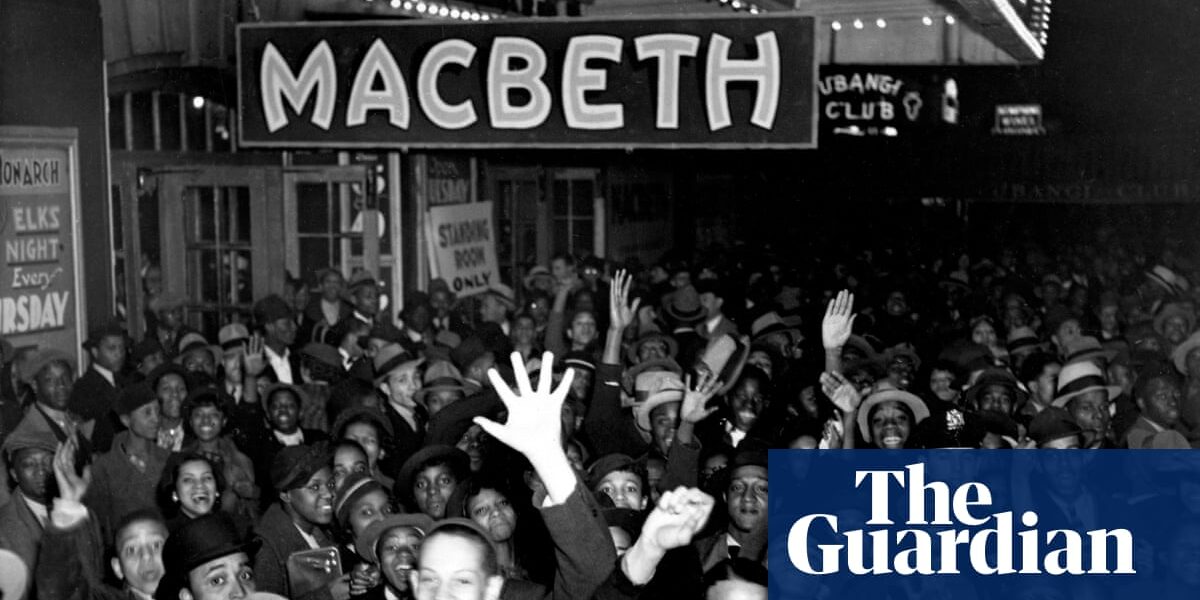
At the beginning of his history of the Federal Theatre, Shakespeare expert James S Shapiro gives the dictionary definition of playbook: both “a book containing scripts of dramatic plays” and “a set of tactics frequently employed by one engaged in competitive activity”. It is the latter that features more than you might expect in his compelling account.
In the midst of the Great Depression, the Roosevelt administration established a national theatre as part of the New Deal. Shapiro, who won the Baillie Gifford prize for 1599: A Year in the Life of William Shakespeare, dramatises that effort from its modest, tumultuous beginnings to its record audience-pulling successes, its pioneering of integrated casts and the ensuing culture war that led to its disbandment.
Perhaps the theatre’s disbandment is better understood as its demise – at the hands of one opportunistic, fear-mongering Texas congressman named Martin Dies. With a chip on his shoulder and a desire to make a name for himself, he led the Special Committee on Un-American Activities, a body created, on paper, to combat communist sympathy and organisation in government. Really it was a way to stymie the New Deal and keep Roosevelt’s progressive agenda in check.
The book cold-opens in 1938 with the Dies Committee (a lesser-known precursor of the postwar House Un-American Activities Committee) interrogating Hallie Flanagan, the producer and playwright who would serve as the director of the Federal Theatre for the duration of its existence. Itching to expose her, one congressman asks whether Marlowe (the long-dead contemporary of Shakespeare) is a communist, causing the televised courtroom proceedings to erupt in laughter. Shapiro skillfully reveals the fundamentally theatrical nature of political hearings, with good and bad actors, and participants eager to derail the initiative without a clear understanding of creativity and theatrical production.
The Federal Theatre was active for only four years, but staged more than a thousand productions in 29 states seen, Shapiro notes, by 30 million people. This feat was accomplished amid rising poverty and a decline in theatre audiences due to the rise of film, as well as active attempts to undermine the project at many turns.
Its programme was genuinely pioneering, and socially radical. The first hit was an all-black staging of Macbeth, set in Haiti and directed by Orson Welles. It drew acclaim from black and white critics despite initial fears it might be “yet another instance of exploitative blackface”. Those fears might not have been so wide of the mark: one of the zaniest accounts Shapiro includes is of choreographer Tamiris (AKA Helen Becker), a forgotten contemporary of modernist powerhouse Martha Graham. She took centre stage in How Long Brethren, a dance performance structured around Lawrence Gellert’s Negro Songs of Protest, and declared: “I will make many Negro dances – I understand the Negro people so well! – their yearnings.”
In any case, it wasn’t long before the Federal Theatre, which, after all, “connected Americans, sitting cheek by jowl, across longstanding political, economic, and racial divides”, was caught in the sights of conservative congressmen. Dies claimed that he was “not seeking publicity” and that the committee would “not permit any ‘character assassination’ or any ‘smearing’ of innocent people”.
But that was exactly what transpired over the next six months, with all norms of impartiality abandoned. Hallie Flanagan would hold her own against the men who repeatedly manipulated what she said or prohibited her from providing adequate responses to interrogations, but spent the rest of her life tormented by the episode. Public opinion duly moved, and in June 1939 Roosevelt singled out the Theatre for closure.
after newsletter promotion
For all that it was beset by overt racism and political interference, the project succeeded, for a time, in creating genuinely consciousness-raising theatre with a racially integrated workforce (from actors to designers, directors, dancers and technicians). More consequentially, perhaps, it provided the template for the kind of cultural clash that has persisted in the decades since. Referencing the Johnson-era national endowment for the arts, under attack to this day, Shapiro notes: “The conservative Heritage Foundation’s list of reasons for eliminating this federal arts program shows how little the rightwing playbook has changed since 1938: taxpayer support of the arts is ‘welfare for culture elitists’, promotes ‘the worst excess of multiculturalism and political correctness’, and ‘demeans the values of ordinary Americans’.” Plus ça change.
Source: theguardian.com


